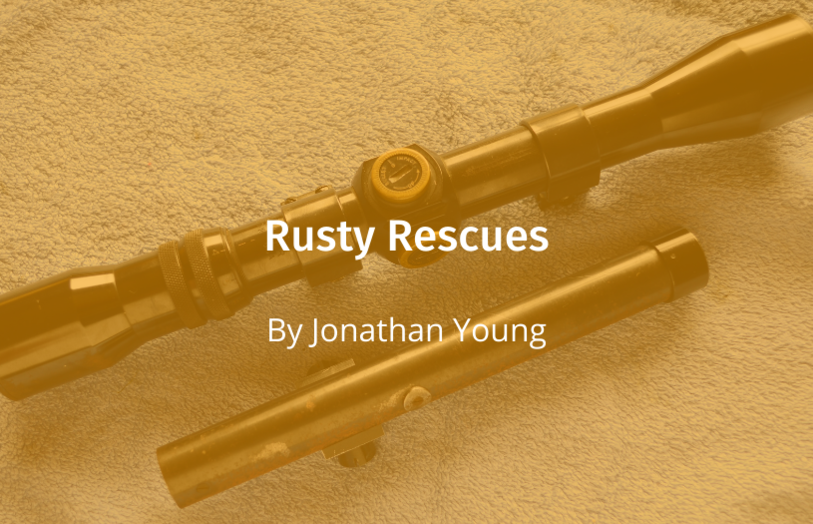
Savage Arms: Long-Range Shooting Specialists
News Events
Create a FREE business profile and join our directory to showcase your services to thousands.
Create my profile now!
Many airgun owners know how nice blued steel can quickly become covered with small rusty speckles. If an airgun or accessory such as a steel-bodied scope is left in a damp state, the surface can become speckled very quickly. These speckles sometimes appear only in specific areas, or worse in large patches to one side. This will be due to where and how the airgun has been stored.
Speckling - although almost invisible at first - is the start of what is a slippery road to ruin for many a fine airgun. Rust speckles spread like chickenpox. Eventually, the speckles are so numerous they develop into a patch covering the entire area and given time eventually the entire object. If caught early this process of slow decay can be tackled with some minor work to stop it. If rust speckles have already developed there are still a number of methods to arrest this process from getting worse.
A nasty rust patch
Simplifying things greatly, these can be chemical processes using rust eating fluids, electro-chemical using an electrical current run through liquids, ultrasonic using sound that bubbles the rust off and abrasion. The latter is a personal favourite; it's simple and costs little compared to other methods that involve chemicals and or expensive kit. Archaeologists and engineers may argue that abrasion is too damaging but with airguns let's face it, we’re not talking about valuable artefact restoration. Hard abrasive scrubbing on small areas will most probably always affect or even damage the surrounding blue or blacking. It’s a tough call - leave and let the rust develop or arrest it and then try to blend things in afterwards. On many occasions rust even if very light may well have already marred the outer blue finish. Time to get on!
Rust speckles - common on smooth steel
To ease the work and help it along applying oil as a lubricant over any rust beforehand helps lift it off the surface as work progresses. Wire wool can be used but depending on the rust and where it is, this may be too coarse unless used in the very fine 0000 grade. A favourite tool is nylon kitchen cleaning pads which have been used here. A multitude of tiny speckles can then be tackled with a soft scourer pad dipped regularly in oil.
An entire airgun, or one side or only a small area of concern can be scrubbed gently with this pad and oil method. The rust will be scrubbed away and carried in the oil. This can be wiped off with some paper kitchen towels and the process repeated until satisfactory. After a final wipe down there should be a smooth surface with no rust. If caught in time in the early stages of rusting, the finish can look totally unblemished.
Feeler gauge blade used as a scraper
On many airguns, there may well be a patchy mottled appearance to the cleaned steel. This will be due to un-rusted steel with its original bluing and the cleaned from rust damaged blued surface. For a vintage airgun, this mottled appearance can on many occasions be acceptable and left as is. Here at home a wipe over with oil once every now and then is the default stop to most rust rescue projects such as this small steel scope featured here. This keeps most airguns and steel accessories in this semi-cleaned condition healthy.
The alternative is to try and match old blued finishes with a modern off the shelf blue solution. If the results don’t match up or look good, then this can result in the need for a full re-blue. In all honestly, this has been seen by many airgunners especially those who collect as undesirable. It all depends on the airgun in question. A rusty vintage Gem has often been given the full bluing treatment and can look superb, even though most Gems were never finished to such a high standard when they left the factory. However, a rusted airgun can be cleaned with care retaining its historical character.
A little time and some patience
If the rust is old, the speckles may have developed and there may be rust pitting now visible. This is where not only the bluing has been eaten but the outer surface of the steel too. This can be minor or major and references to how long a piece of string gives some idea of how bad some airguns end up looking like.
So speckles develop into patches that can cover larger areas. For this, one method that works really well is to use a thin steel blade to scrape or shave the outer rust away. Simple, time-consuming but very effective and without the need for chemicals. The favourite tool for this is a set of feeler gauges which has a selection of thin blades. Selecting a blade, it’s drawn across the surface at an angle to literally scrape the rust away. Pressure is needed but not so much as to dig into the steel surface.
Nylon kitchen pad and oil
Nylon pad treatment
Inevitably some scratching and damage can result. However, if this process has been found necessary then the project piece will be in a bit of a state anyway. Afterwards, some wire wool or abrasives can be used to smooth such minor damage and cleaning irregularities but again only where absolutely necessary. On a number of occasions such as here with a large scope, nothing else was done to this other than a clean and wipe over with some oil afterwards. Trying to match this scope's original magnificent glossy blacking with an off the shelf retail bluing solution today would have created even bigger headaches. Many owners will be satisfied with these two simple rust removal and stabilisation techniques.


